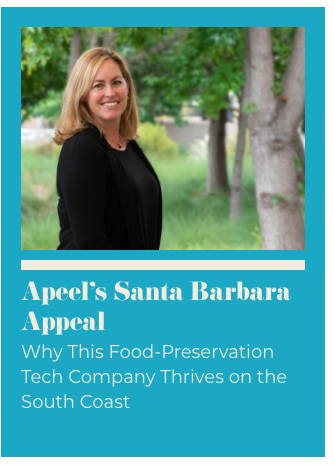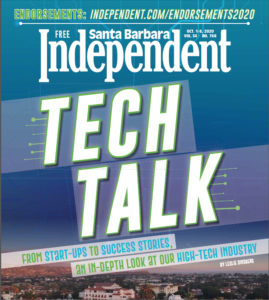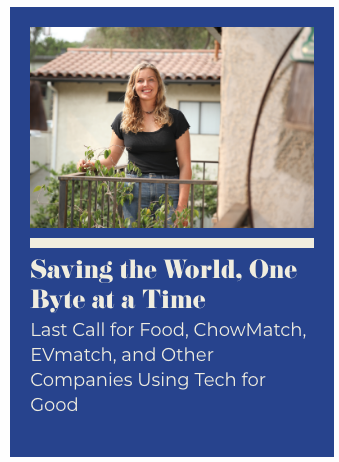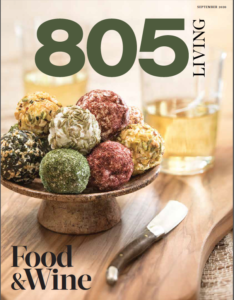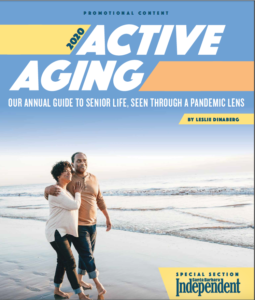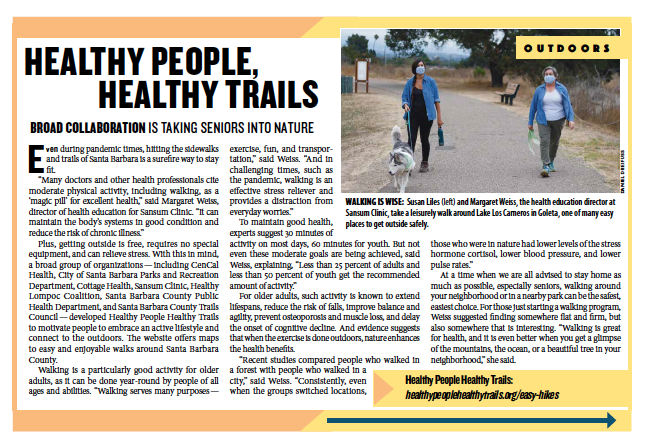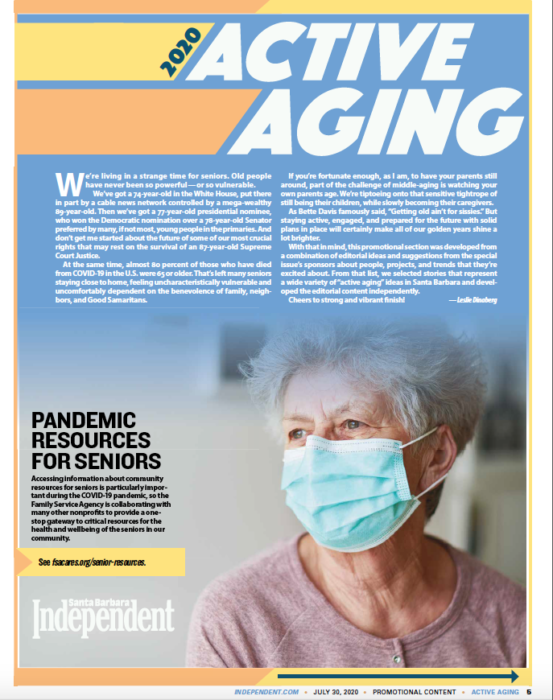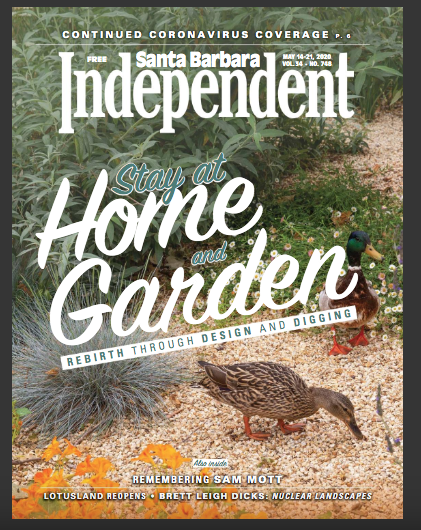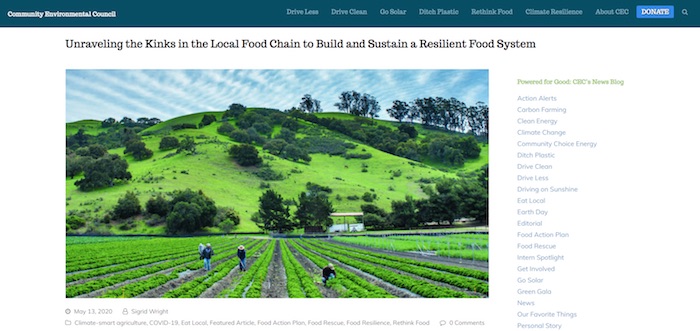
This story was published on cecsb.org on May 13, 2020.
Like a heat map, the COVID-19 pandemic has drawn attention to areas of strain, places where we need to pay greater attention. One of the most noticeable of these is the food system.
This week, two of the founding members of the Santa Barbara County Food Action Network — Erik Talkin, CEO of Foodbank of Santa Barbara County, and Sigrid Wright, CEO of the Community Environmental Council — sat down with food writer Leslie Dinaberg to discuss how COVID-19 is sending shock waves through a fragile global food system, and why this is a particularly good time to build a healthy, sustainable and decentralized food system. They draw on the guiding framework of an action plan published in 2016 and developed in collaboration with the Santa Barbara Foundation, the Orfalea Foundation, and more than 200 community members.
Leslie Dinaberg: A few years ago when you were developing the Santa Barbara County Food Action Plan, your intention was to “future proof” the local food system, though presumably, you weren’t anticipating that a pandemic would test it so brutally. What are you thinking now?
Sigrid Wright: We’ve had other disasters that have had a ripple effect through the food system, but the COVID 19 pandemic is sending reverberations through the system unlike anything most of us have experienced in our lifetime, in part because it’s global, and in part because it’s both a public health crisis and an economic crisis. This is a good time to be talking about why we want to build a healthy, sustainable and decentralized food system, because the global system has a lot of fragility to it.
Erik Talkin: The food system now is so hyper-organized and so dependent on every little link of the chain from here to China and back, that one break in that chain creates a lot of problems. The Foodbank has seen a 60% decrease in the amount of food that we get donated because grocery stores are selling out of food that would normally be provided to us. At the same time, our donations from the agricultural community, primarily the Santa Maria Valley, are up by 50% from this same month last year.
So that’s an indication that local growers have products available. Obviously they have their own problems with food distribution, as there are no schools or hotels operating, but we have a system in place that has allowed excess food to be effectively used. People are reading in the New York Times and elsewhere about milk being poured away and crops being plowed under, but that’s not happening really significantly in California.
LD: Are there any supply chains that are likely to be disrupted so that you won’t be able to access certain products a few months from now?
ET: Yes, there already have been disruptions in that the supply chain is overheated and unable to respond to requests. The Foodbank spent a quarter of a million dollars a couple of weeks ago on food that we haven’t received yet, because it’s slow in coming and our order is not as big as other orders.
Overall, in theory, there’s enough food in the country, but in terms of specific foods, we are already unable to get everything we would like.
SW: The modern food system is designed for speed and convenience. It’s highly efficient and certain aspects of it are really compacted, particularly around meat processing. From what I’m hearing, I would expect to see shortages of meat within the next few months.
This relates to Santa Barbara County because although we’ve traditionally been a cattle region and still do raise a lot of cattle here, we no longer have processing facilities. The same is true of fisheries. We have access to a good amount of animal protein on the Central Coast, but everything has to be shipped out, processed, and shipped back. That was one of the many issues that surfaced with the Food Action Plan: how do we decentralize some of those processing facilities so they are local?
LD: What have you learned about Santa Barbara’s food resilience in the past couple months that you didn’t anticipate?
SW: On the production side, pretty much every small farmer and fisherman is having to think on their feet and make some drastic adjustments to their business models as people are shopping less at farmers markets, and as schools and restaurants stop their orders. They’re having to go direct-to-consumer, often in inventive ways, whether that be a pop-up farmstand or more community supported agriculture boxes. Managing those new market routes is like picking up a second job: the first one being food production, the second being the delivery and marketing through different channels.
I’m also really concerned for our local restaurants. After the Thomas Fire, many businesses were barely hanging on or were just starting to recover, and now they’ve gotten hit again. We may lose a lot of local capacity, both on the producer end with farmers and fishermen and then on the consumer end with restaurants. That to me is a sadness. I personally am not ready for a future in which I get most of my food from Amazon.
ET: There haven’t been the types of runs and shortages over the last few weeks that theoretically could have happened, but I think we are still at the beginning of this crisis. People are afraid to go out and stand in line to get food. Toward the end of the summer, once the economic impacts have really cut deep — with people who are working but have large debts, and people who are still out of work — we’ll have a huge need for additional food for the community. That food can’t all be produced here, but has to be purchased or donated within the state and nationally.
LD: Is there a government entity to help with that?
ET: There’s a national emergency food program called the Coronavirus Food Assistance Program that is designed to pay local distributors to put together food boxes and make those available to either Foodbanks or to be distributed directly. So we’re having to go out to all of these people and say, “Do you want to be involved in this program? You get paid to provide this food, you get paid to truck it to a particular location.” But it’s a hugely complex 17-page application. Companies like Jordano’s, which is probably our largest local direct food distributor, don’t want to be involved because there’s not enough money in it for them.
The government, in a way, is trying to respond to this issue of food being dumped by offering incentives further down the chain than previous incentives. But there’s not the time or the organization or the planning to make them successful in anything more than the very short term.
SW: The Santa Barbara County Food Action Network, which was spearheaded by CEC and the Foodbank to implement the Food Action Plan, is looking at how we deal with all of this locally. One solution is to create a food hub, so that those who have products have a central vehicle for getting information out about them.
LD: Let’s talk about how this situation is affecting labor. According to the Food Action Plan, the agricultural sector is Santa Barbara County’s primary economic driver, and nearly 20,000 residents work in food and beverage stores or service locations. What are you seeing?
SW: It’s a bitter irony that people who work in the food system — in the fields or grocery stores for example —are deemed as essential workers, and yet they are not being protected as essential workers.
In our region we are really seeing this with farm workers who just don’t have the proper protection and are often having to work shoulder to shoulder. We saw similar inequities in other crises like the Thomas Fire, where it wasn’t until groups like CAUSE and MICOP got involved when farm workers had access to the N-95 masks that everyone else already had. We need the public to strongly advocate for protection for our farm workers, our seasonal workers, our grocery workers, so that they have safe conditions.
ET: It should be a requirement for the employers to do that. Even at the Foodbank — we have very stringent rules and we’ve been wearing masks and gloves for weeks — people just can’t help congregating together in tiny spaces and I’m constantly chasing away people. (Laughs) I’ve been doing that for years, but now I have an excuse to break up the party.
LD: What are you seeing at the home level? Food waste is certainly top of mind right now because no one wants to go out and buy food any more than they have to.
ET: At the most basic level of individuals, people are being forced to reckon with having to provide for their own nutritional health and to sit down and make something to eat, which wasn’t necessarily the case in the past. This may be an opportunity for people to increase food literacy and their understanding about how to take care of themselves and be healthy with food.
SW: We’re clearly seeing a shift in shopping and eating patterns as more people are cooking at home. I know the news media are using the word “hoarding,” but I don’t love that language. What I’m seeing is that people are trying to do a couple weeks of shopping at one time to reduce their exposure. It’s good people are shifting their behavior, but that caused some of the slowdown that Erik referred to.
Again, it’s not that the supply chain has a shortage of food, although there may be some gaps in things that we may not have access to when and how we want it. I think we’ve gotten quite spoiled, frankly, because we’ve built a food system that was designed around getting things fast and conveniently. To really be resilient you need some amount of redundancy and things that are less consolidated.
LD: When you are providing food from the Foodbank, how many days worth of food are people picking up at one time?
ET: We typically give out bags of groceries that are about 30 pounds. We’ve begun to switch to boxes which are slightly bigger, so there’s a variety of dry goods, canned goods, fresh produce, fresh meat, but it’s not your total dietary or meal requirements for that period of time. The food that we provide is supposed to be a supplement to the other food you’re getting. It is possible to go to more than one place if your need is greater.
We see the need for that type of food increasing dramatically and there’s been a real kind of blockage with the USDA food. There’s definitely problems with the emergency food distribution network, as well.
LD: Beyond the critical need for emergency feeding, at this moment is there anything else that stands out from the Food Action Plan?
ET: I think people’s understanding of the need to have more fully developed local networks for both distribution and availability of food is important.
We talked earlier about the need for local processing for seafood and meat, but that’s also a need for agricultural products. For example, if facilities were available we could make spaghetti sauces and other things out of produce before it goes bad. There’s a lot of potential there, but it requires an investor. It may be something we have to think about in more of a tri-county way.
LD: That feels like such a great way to use some of those kitchens that aren’t being used right now.
SW: One of the projects of the Food Action Network was to map out sites that could serve as community kitchens. In good times they might be used to make the value-added products that Erik was talking about. If farmers had a bumper crop of tomatoes, they could hand that off to a caterer to go in for a couple of weeks and make tomato sauce, for example. In bad times like now, community kitchens could be used to help with disaster feeding.
LD: This is obviously an excellent opportunity for us to illustrate the importance of protecting the local food system. What are some things that individuals can do right now?
ET: Continuing to utilize local farmers markets, purchasing from smaller local stores to enable those stores to be able to weather the current situation, and keeping away from chain stores. I think that restaurants will be gradually opening up in a more limited fashion, so just make sure that you’re supporting local restaurants, even with a kind of take out environment that we have at the moment.
SW: At the moment there are still some strengths in the local food system, and there is some scrappiness. We are a community that does seem to care about this kind of stuff.
One of the outcomes of all of this is that people are actually talking about things like the food system, either using that phrase or having a great awareness. Hopefully that will have a positive effect. But protecting the local food system will mean that we will have to step in as individuals and really support it.
ET: Every generation needs something to wake it up a little, so I guess this is it.
Originally published on cecsb.org on May 13, 2020.

